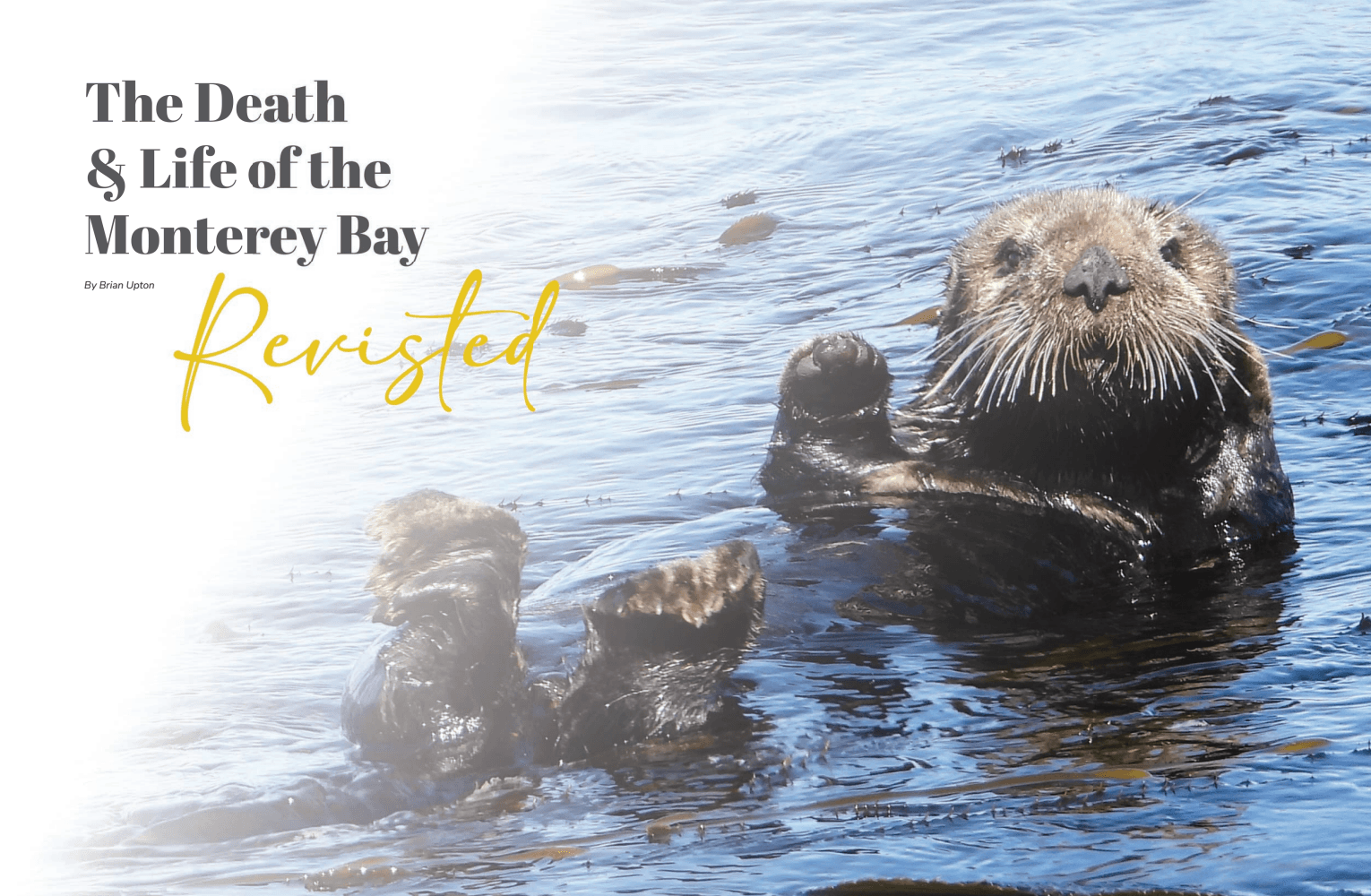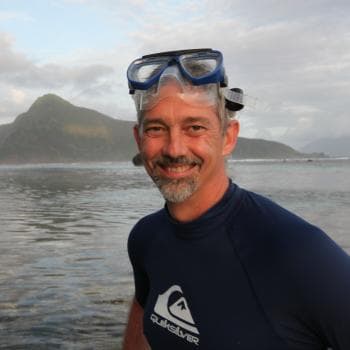Santa Cruz Vibes recently caught up with Palumbi to reflect on the past and discuss not only the current state of Monterey Bay but also its role in the broader conversation about global warming and climate change.
Strangely, it was the bay’s pristine nature and a healthy dose of guilt that inspired the original work The Death & Life of Monterey Bay
“I was traveling all over the world, talking to people about the ocean’s perils—threats from overfishing, climate change, and pollution—and then I would return home, and the bay was breathtakingly gorgeous, leaving me with a hint of guilt,” Palumbi said.
The pristine condition of the local ecosystem left him questioning, “How did we miss all these issues here when I was observing them almost everywhere else?” Palumbi and co-author Sotka delved into the matter and swiftly found the answer.
“As it turns out, Monterey Bay had all those problems and, in some ways, it was worse,” says Palumbi of a body of water that is difficult to fathom at a local level.
“It had the same problems I was witnessing elsewhere. The water was polluted, air quality was terrible, seals, otters, whales, abalone, and sardines—all gone. The difference between Monterey Bay and other places was that it started to improve.”
The book weaves a tale of a Monterey Bay ravaged by human activities, on the verge of ecological collapse but ultimately emerging as a symbol of resilience and a beacon of hope for environmental restoration.
To make the narrative more manageable, Palumbi and Sotka divided the book into three digestible sections for readers: The Ruin, The Turnaround, and The Revival.
THE RUIN
The ruin of Monterey Bay resulted from decades of human exploitation and neglect. Starting in the 1850s, overfishing, pollution, and habitat destruction wreaked havoc on what had once been a delicate balance, pushing numerous species to the brink of extinction and leaving the bay teetering on the edge of ecological collapse. It was a period marked by a loss of biodiversity, declining fish populations, and a devastating decline in overall bay health.
“The ruin began almost as soon as Westerners arrived on the Monterey shoreline. They witnessed the bay’s abundance and diversity and recognized the global market demand for many of those resources, particularly otter pelts, which they saw as a lucrative opportunity,” Palumbi explains, attributing the motivation more to capitalism than a deliberate intent to destroy an ecosystem.
“They didn’t set out to ruin Monterey Bay. They simply followed the prevailing business model in the ocean, which was to find ways of extracting resources and selling them for profit. They fished, made money, and repeated the process until there was nothing left. When they couldn’t make any more money from whales, they switched to otters, and when otters were no longer viable, they moved on to something else.”
THE TURNAROUND
Monterey Bay underwent a dramatic transformation with the emergence of dedicated individuals and organizations committed to its restoration. Scientists, conservationists, and local communities joined forces, recognizing the urgent need for change. Their collective efforts led to the establishment of the Monterey Bay National Marine Sanctuary.
At the forefront of this revitalization was Julia Platt, an activist who eventually became the Mayor of Pacific Grove. Platt displayed a clear understanding of the devastation caused by the canning industry in the bay. With the support of local businesses and hotel owners, she took action by suing the cannery owners in an effort to protect the shoreline. Although successful in court, the ruling did not result in any practical measures against the canneries. Undeterred, Platt took matters into her own hands by forming an alliance with scientists from the Hopkins Marine Station. Together, they pushed for a law that granted Pacific Grove the management rights of the shoreline.
It is safe to say that Palumbi considers Julia Platt the heroine of this story.
“You simply couldn’t look away from Julia. Such an amazing person. During our thorough research of the Pacific Grove archives, we stumbled upon a remarkable scientist, person, and activist who, without a doubt, deserved greater recognition.”
Palumbi also emphasizes that Platt serves as a role model for change – both in the past and present.
“Julia Platt, along with many others such as Samuel FB Morse and Ed Ricketts, demonstrated that individual action, even if it requires significant time, effort, and enduring patience, can truly make a substantial difference in the world.”
THE REVIVAL
The eventual revival of Monterey Bay stands as a testament to the transformative power of collective action undertaken by activists during a crucial period. Through their groundbreaking research, community engagement, and strong advocacy for environmental policies, the bay underwent a remarkable transformation.
Over time, fish stocks rebounded, marine habitats began to recover, and a resurgence of biodiversity became apparent. The reappearance of sea otters, vibrant kelp forests, and thriving marine life in the 1960s reignited hope and admiration for nature’s resilience. It also solidified our beloved bay as a symbol of hope and a paradigm for successful ecological restoration.
TODAY
The story of the Monterey Bay is not without some cautionary lessons. Both authors make a determined point to underscore the need for ongoing vigilance and sustainable practices to ensure the bay’s long-term viability. The authors emphasize that, much like a century ago, there are evident warning signs on the horizon that demand our attention.
Palumbi highlighted two pressing concerns regarding the future of Monterey Bay: local desalination efforts that could be environmentally harmful and the potential repercussions of global climate change. He pointed out that while the historical approach of conservation biology, which seeks to restore ecosystems to their original state, may have some impact, it might not be sufficient.
“That is what was really so critical with, for example, the sea otters. Bringing them back was critical for the survival and the revival of the kelp forests in Monterey Bay. Everything is connected, so that part has to happen. But in the future, staying static as to what has worked in the past is not necessarily going to be enough.”
Everything is interconnected, and thus, this interconnectedness must be acknowledged and addressed, Palumbi added.
Considering this perspective, the revitalization narrative of the “Death and Life of Monterey Bay” serves as a powerful reminder of our role as environmental stewards and the collective actions necessary to ensure the future well-being of our planet.
The revival of Monterey Bay can serve as a guiding example for other imperiled ecosystems across the globe, emphasizing the significance of proactive conservation efforts and the potential for restoration, even when faced with seemingly overwhelming obstacles.
EPILOUGE
Equipped with the paradigm of ruin, turnaround and revival as presented in the book, I posed a broader question to Palumbi.
SC VIBES: I’m going to put you on the spot. Is the planet in the ruin stage or a turnaround?
PALUMBI: Oh, I think we’re still very much on the downward track into the ruin. We’re heading for the bottom. You can see that in the levels of carbon dioxide going into the atmosphere and the predictions of heat waves and storms and heat domes. Think about it. How many different terms are there for erratic storms that we never had before? It is an interesting way of calculating the impact of all these things on people.
SC VIBES: So that brings me to the doomsday question that came to me working on the article. The key component of the Monterey Bay turnaround was the politics of the time aligning with the activism. I look at the landscape from a global perspective and I see more than enough “Mayor Platt-like characters” sounding the alarm, but I cannot connect the dots to the politics aligning to initiate the turnaround.
PALUMBI: Right. We don’t want the world to look like Cannery Row to wake people up to what is at stake for the planet. Cannery Row was a disaster area. It was like a thriving ecosystem that turned into a moonscape. The turnaround was initiated because it essentially went economically bankrupt and humanly bankrupt. People couldn’t live there. They couldn’t make money there or raise families. They fled in different directions. That is the key difference. In this comparison, fleeing is not an option in the world because we only have this one planet. There is simply nowhere to run. So, letting the world fall into the devastation of Cannery Row in order to motivate action to come out the other side, to escape the ruin, is not what we particularly want to do.
SC VIBES: Can we talk about the 6th Mass Extinction ?
PALUMBI: That is a whole new conversation and I definitely think we need to keep talking.
Editor’s Note: This is the first of a two-part series. In the Next issue of Santa Cruz Vibes Magazine the story continues with, “Planet into the Ruin: The Sixth Mass Extinction.”



